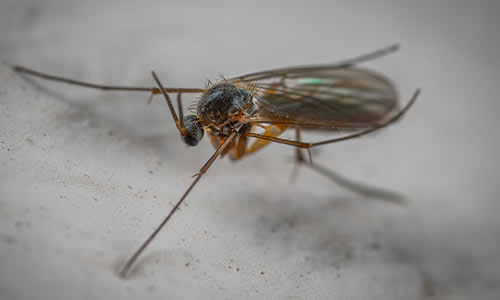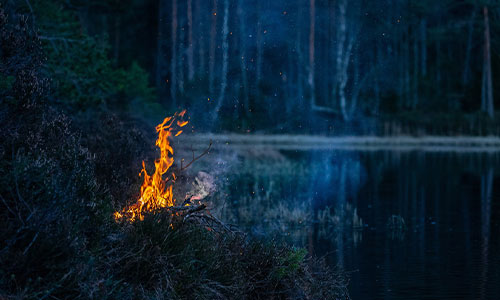How Can You Stay Away From Midges on Hiking and Camping Trips
Author

Javier Olivo is a blogger and a writer by heart. In the past, Javier worked as a woodcarver in a furniture store in his hometown. Being exposed to the outdoors, he often likes to give advice to people who prefer trekking in the woods. During his free time, Javier loves going to the gym and playing football.
You will come across several difficulties while getting on a trekking or camping journey. The wild and lush greenery in the forests is the home of many insects, midges are one among them. These blood-sucking creatures can be a nuisance to hikers and campers. But do not worry, because the following post outlines tips and strategies for how to avoid midges and enjoy your outdoor experiences without itchy irritation.
- What Are Midges?
Midges are small insects with sharp jaws that can suck blood as it comes in contact with your skin. The male midges suck on nectar and they do not bite humans usually. But the female midges bite the skin to get enough blood that would help them to develop and mature their eggs. Though female bites are painless but leave an itchy red mark on your skin that may worsen if you keep scratching the bumps.

- Midge Prevention Tips
Summertime is the most ideal season for midges but they are hardly seen when the winter breeze or frost arrives. They usually appear during the sunrise and sunset. It is easier to avoid midges during the summer evenings because the sun sets late. Moreover, midges are attracted to the carbon dioxide gas which is exhaled by human beings as well as their sweat. Therefore, it is better to stay inside your camp as you may get caught amongst midges if you are spending some time outside the tent during the dawn and dusk timings.
- Research the Area Before You Go
Midges are found in large groups near water sources because female ones lay eggs near coastal places. They also reside in areas having thick grasses and tree barks. Therefore, it is better to avoid camping near woodland and water bodies so that your sleep schedule is not ruined in the jungle.
Moreover, you must do proper research before deciding on an area for camping or hiking. They are found in large numbers in damp places which receive high rainfall. For example, the west coast of Scotland is a wet area where you will find these insects in large numbers due to heavy rainfall. On the other hand, the east coast of Scotland relatively receives less rainfall and can be preferred for hiking or camping journeys.
- Wear Protective Clothing and Pale Colours
A simple solution to avoid getting bitten by midges is to wear a full sleeve T-shirt and full-length trousers that will leave less skin exposed to insects. Moreover, it is preferable to wear pale-coloured clothes because midges are more attracted towards bright colours. The best option is to wear beekeeping-inspired clothing to completely prevent bites. Therefore, do prefer packing light-coloured bed covers, blankets, and clothing than dark ones.
- Take Insect Repellents
You can also opt for chemical-based insect repellents to avoid contact with midges while on the trek. Do check if the repellent has DEET, IR3535, saltidin or citriodiol, which are the best-known ingredients to keep away midges. Do not forget to apply the repellent on your skin during the morning as well as evening for best protection against bites.
- Look For Breezy Areas
Midges cannot sustain in any area having even a light breeze. Ensure to choose an area where there is a breezy atmosphere so that midges are at bay. In addition, do check that your camp or tent is properly tucked in at the breezy places.

- Campfire and Candles
Smoke is a natural repellent for midges since it creates an uncomfortable environment for insects. So, you may opt for a campfire to avoid the presence of midges around your temporary residing place. You may also burn candles to get rid of these blood-sucking insects.
Therefore, you must keep in mind all the above-mentioned precautions as well as suggestions to avoid the uncomfortable experience of getting bitten by midges on your journey.
Author

Javier Olivo is a blogger and a writer by heart. In the past, Javier worked as a woodcarver in a furniture store in his hometown. Being exposed to the outdoors, he often likes to give advice to people who prefer trekking in the woods. During his free time, Javier loves going to the gym and playing football.
Categories
- Sport (28)
- Product Reviews (3)
- Team Outdoor Look (7)
- Mike Wild (2)
- Mike Payton (2)
- Suse Hammond-Pears (3)
- Snowboarding (12)
- Latest Offers (105)
- Shop Talk (1)
- Competitions (7)
- Walking (413)
- Lifestyle Fashion (8)
- Travel (86)
- Kit Guides (176)
- Workwear Clothing (6)
- Safety Workwear (4)
- Health/Fitness (289)
- Skiing (91)
- Great Outdoors (1316)
- Cycling (92)
- January 2025
- December 2024
- November 2024
- October 2024
- September 2024
- August 2024
- July 2024
- June 2024
- May 2024
- April 2024
- March 2024
- February 2024
- January 2024
- December 2023
- November 2023
- October 2023
- September 2023
- August 2023
- July 2023
- June 2023
- May 2023
- April 2023
- March 2023
- February 2023
- January 2023
- December 2022
- November 2022
- October 2022
- September 2022
- August 2022
- July 2022
- June 2022
- May 2022
- April 2022
- March 2022
- February 2022
- January 2022
- December 2021
- November 2021
- October 2021
- September 2021
- August 2021
- July 2021
- June 2021
- May 2021
- April 2021
- March 2021
- February 2021
- January 2021
- December 2020
- November 2020
- October 2020
- September 2020
- August 2020
- July 2020
- June 2020
- May 2020
- April 2020
- March 2020
- February 2020
- January 2020
- December 2019
- November 2019
- October 2019
- September 2019
- August 2019
- July 2019
- June 2019
- May 2019
- April 2019
- March 2019
- February 2019
- January 2019
- December 2018
- November 2018
- October 2018
- September 2018
- August 2018
- July 2018
- June 2018
- May 2018
- April 2018
- March 2018
- February 2018
- January 2018
- December 2017
- November 2017
- October 2017
- September 2017
- August 2017
- July 2017
- June 2017
- May 2017
- April 2017
- March 2017
- February 2017
- January 2017
- December 2016
- November 2016
- October 2016
- September 2016
- August 2016
- July 2016
- June 2016
- May 2016
- April 2016
- March 2016
- February 2016
- January 2016
- December 2015
- November 2015
- October 2015
- September 2015
- August 2015
- July 2015
- June 2015
- May 2015
- April 2015
- March 2015
- February 2015
- January 2015
- December 2014
- November 2014
- October 2014
- September 2014
- August 2014
- July 2014
- June 2014
- May 2014
- April 2014
- March 2014
- February 2014
- January 2014
- December 2013
- November 2013
- October 2013
- September 2013
- August 2013
- July 2013
- June 2013
- May 2013
- April 2013
- March 2013
- February 2013
- January 2013
- December 2012
- November 2012
- October 2012
- September 2012
- August 2012
- July 2012
- June 2012
- May 2012
- April 2012
- March 2012
- February 2012
- January 2012
- December 2011
- November 2011
- October 2011
- September 2011
- August 2011
- May 2010
- April 2010
- March 2010
- February 2010
- January 2010
- November 2009
- October 2009
- September 2009


Submit a Comment